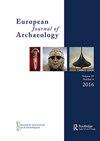宗教和世俗背景下的财富——对近代早期葡萄牙陶器消费的批判性分析
IF 1.4
2区 历史学
0 ARCHAEOLOGY
引用次数: 0
摘要
考古遗址的财富差异是一个经常研究的话题,但社会差异方法很少应用于更广泛领土内的不同背景,特别是在葡萄牙。在这篇文章中,作者通过16世纪到19世纪葡萄牙15个地点的餐具消费来讨论财富和不平等的差异。考古证据来自两种类型的背景:世俗(房屋和垃圾场)和宗教(女性和男性宗教机构)。作者使用统计相似性方法来比较每种情况下的不同消费模式,讨论了这如何帮助我们理解不同社会环境中的财富差异。本文章由计算机程序翻译,如有差异,请以英文原文为准。
Wealth in Religious and Secular Contexts: A Critical Analysis of Pottery Consumption in early modern Portugal
Wealth differentials in archaeological sites are a frequently studied topic, but social differentiation approaches are rarely applied to different contexts within a wider territory, especially in Portugal. In this article, the authors discuss the differences in wealth and inequality through the consumption of tablewares from fifteen sites across Portugal dated from the sixteenth to the nineteenth centuries ad. The archaeological evidence derives from two types of contexts: secular (houses and dumps) and religious (female and male religious institutions). Using a statistical similarity method to compare different consumption patterns in each context, the authors discuss how this can help us understand wealth differences in distinct social environments.
求助全文
通过发布文献求助,成功后即可免费获取论文全文。
去求助
来源期刊

European Journal of Archaeology
ARCHAEOLOGY-
CiteScore
3.40
自引率
6.70%
发文量
58
期刊介绍:
The publication organ of the European Association of Archaeologists, the European Journal of Archaeology seeks to promote open debate amongst archaeologists committed to a new idea of Europe in which there is more communication across national frontiers and more interest in interpretation. The journal accepts not only new empirical data and new interpretations of the past but also encourages debate about the role archaeology plays in society, how it should be organized in a changing Europe, and the ethics of archaeological practice. All periods are covered; papers, review articles, interviews and short "debate" pieces are all sought. Whilst English is the primary language of publication in the EJA, papers submitted in French or German will be given equal consideration.
 求助内容:
求助内容: 应助结果提醒方式:
应助结果提醒方式:


